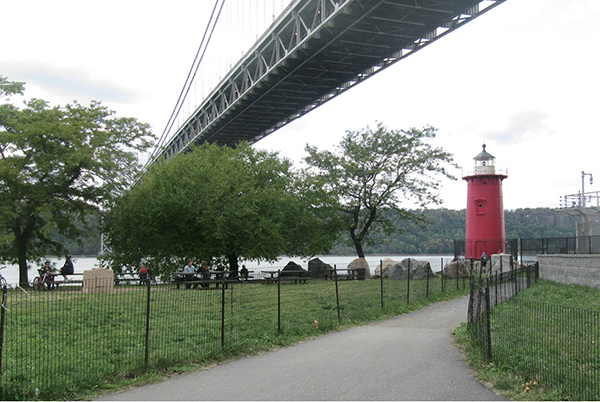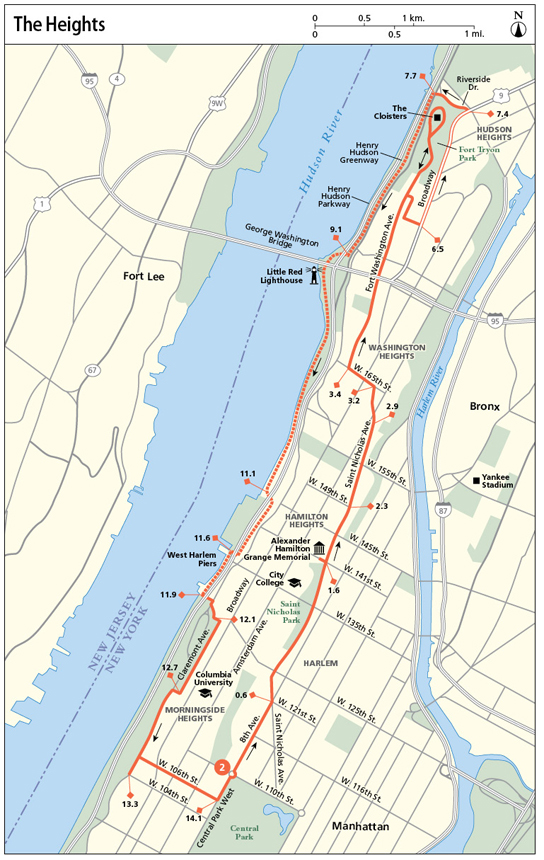2
The Heights
This ride through the Heights of Manhattan travels from Central Park along historic Saint Nicholas Avenue through Morningside, Hamilton, Washington, and Hudson Heights. You’ll travel through the Hamilton Heights historic district, past neo-Gothic spires, and a founding father’s home. Then, Fort Tryon Park affords sweeping views of the New Jersey Palisades across the Hudson River and houses the Cloisters Museum and Garden, well worth a visit regardless of your interest in medieval art or architecture. You’ll return southward along the Hudson River Greenway, framed by the Hudson River on one side and the towering cliffs of Fort Tryon Park on the other.
Start: The northwest corner of Central Park
Length: 14.3-mile loop
Approximate riding time: 2.5 hours
Best bike: Hybrid, road, or mountain bike
Terrain and trail surface: The route is paved throughout. It goes steadily uphill toward Fort Tryon Park. It goes steeply downhill from there to the Hudson River.
Traffic and hazards: The first half of this route runs along on-road bike lanes on wide city streets, giving cyclists ample space. Traffic here is light on weekends, moderate on weekdays. Stay alert especially at West 162nd Street, where Saint Nicholas Avenue crosses Amsterdam Avenue diagonally. Also, at the north end of your journey, to access the Hudson River Greenway, you have to cross an access road to Henry Hudson Parkway. Stay alert. The second half of the route runs on a car-free greenway.
Things to see: Alexander Hamilton Grange Memorial, Fort Tryon Park, The Cloisters, Hudson River, Palisades, Little Red Lighthouse, Riverside Church, Barnard College, Columbia University, Hamilton Heights, Washington Heights, Hudson Heights
Maps: New York City Bike Map
Getting there: By public transportation: Take the B or D subway to the Cathedral Parkway stop at the northwestern corner of Central Park. This is your starting point. GPS coordinates: N40 48.015’ / W73 57.482’
THE RIDE
The first portion of your journey leads northward, with Morningside Heights on your left and Central Harlem on your right. You’ll hug the east edge of Saint Nicholas Park, a narrow, steeply sloping park that leads up to the neo-Gothic spires of City College. At the north end of the park, at West 141st Street, you can reach founding father Alexander Hamilton’s Harlem home on your left. Stop off to explore the historic house museum if you wish.
Continuing en route, Saint Nicholas Avenue goes steadily uphill through the Hamilton Heights historic district. Follow the bike route as it swings diagonally across the traffic island to your left at West 162nd Street, where Saint Nicholas Avenue intersects Amsterdam Avenue. Continuing northward, Fort Washington Avenue up ahead continues slowly and steadily uphill to Fort Tryon Park. As you travel underneath the George Washington Bridge, you’re likely to encounter a flurry of cyclists heading to and from the bridge. This soon brings you to Fort Tryon Park, sitting high on a bluff overlooking the Hudson River. Enter the park via Margaret Corbin Drive, which loops to the north end of the park, where you’ll find the Cloisters, a branch of the Metropolitan Museum of Art. Made of architectural components from an amalgam of twelfth- to fifteenth-century religious structures, the Cloisters contains medieval European art. Explore the museum if you wish or find a spot in the surrounding gardens for a break overlooking the Hudson River.

The Little Red Lighthouse at the foot of the George Washington Bridge was built in 1880 and is now a popular cycling stop.
To continue, exit Fort Tryon Park to soon go steeply downhill via West 187th Street. A short on-road portion here takes you along the foot of Fort Tryon Park, continuing northward. When you reach Dyckman Street at the end of the park, use caution as you make a sharp left turn onto Riverside Drive. (Use the pedestrian crosswalk if need be.) At the end of Riverside Drive, use caution once more when the road splits into north- and southbound access roads for the Henry Hudson Parkway. Cross the northbound access road to mount the sidewalk (bikeway) on the right of the southbound access road. Follow the sidewalk as it travels under the parkway. Then dismount your bike, ascend the stairs to your right, and head south on the Hudson River Greenway.
Enjoy the car-free journey southward, with views of the Hudson River on your right and the cliffs of Fort Tryon on your left. The George Washington Bridge in the distance looms ever-larger as you continue south. Just before reaching the bridge, the greenway snakes right and then left to journey underneath the bridge and emerge next to the Little Red Lighthouse. This proud-looking 40-foot-high bastion was built in 1880 (at a different spot) and is a popular resting spot for cyclists.
Continuing southward along the greenway, views of the city skyline greet you in the distance until you reach the West Harlem Piers. You’ll then leave the greenway behind at Saint Clair Place to go steeply uphill along Riverside Drive to your right. At the top of the hill, you’ll veer onto a quiet, narrow road, Claremont Avenue, which takes you past an array of educational institutions in historic buildings—Barnard College; Bank Street College; the Manhattan School of Music. At West 116th Street you can turn left to visit Columbia University’s campus, New York State’s oldest college. Alternately (or thereafter), head west on West 116th Street toward the Hudson River once more to return to your starting point.
Alexander Hamilton
After having been orphaned as a young teenager on the Caribbean island of Nevis, Alexander Hamilton came to New York when he was 17 years old to study at what now is Columbia University (then King’s College). Thirty years later, in 1802, after playing a pivotal part in the founding of this country, he had this Harlem home built and named after his father’s ancestral home in Scotland. Now a national memorial, the historic house museum contains period rooms restored to resemble their Hamilton-era appearance and interactive displays that put the man into context. It also offers sweeping views of Harlem and beyond.

MILES AND DIRECTIONS
0.0 Bike counterclockwise around the traffic circle and take the second right onto Frederick Douglas Boulevard/8th Avenue’s on-road bike lane.
0.6 Just north of West 121st Street, Saint Nicholas Avenue diagonally crosses 8th Avenue. Cross to the north side of Saint Nicholas Avenue. Then swivel left to use the traffic signal to continue northward along Saint Nicholas Avenue.
1.6Turn left onto West 141st Street. The Alexander Hamilton Grange Memorial house sits at the top of the hill on your left. Visit if you wish. Then, to continue en route, retrace your path down West 141st Street to continue northward on Saint Nicholas Avenue.
2.3When the road forks at West 149th Street, veer left to stay on Saint Nicholas Avenue.
2.9At West 161st Street, follow the bike route diagonally across the traffic island to your left. Descend the island on the other side to diagonally cross Amsterdam Avenue, using the traffic signal. Continue north along Saint Nicholas Avenue on the other side.
3.2Turn left onto West 165th Street.
3.4Turn right onto Fort Washington Avenue.
4.9Enter the traffic circle, veering right. Take the first right exit onto Margaret Corbin Drive, entering Fort Tryon Park.
5.2When the road forks, veer right to continue along Margaret Corbin Drive.
5.4The Cloisters is on your left. Visit if you wish. To proceed en route, continue along Margaret Corbin Drive, following the road as it loops left to go south. Take a break anyplace along the way.
5.9Exit Fort Tryon Park; bike counterclockwise around the traffic circle to exit southward onto Fort Washington Avenue.
6.1Turn left onto West 190th Street and follow the road as it turns right, heading downhill.
6.3Turn left onto West 187th Street.
6.5Turn left onto Broadway. At Sherman Avenue, veer left to continue along Broadway.
7.4Make a sharp left onto Riverside Drive (using the pedestrian crosswalks if you wish).
7.7Slow down as you reach the end of Riverside Drive at Staff Street. Riverside Drive forks to become the access roads for Henry Hudson Parkway. Cross Staff Street and the parkway’s northbound access road to mount the sidewalk (bikeway) on your right along the southbound access road. Go underneath the overpass, dismount your bike, and ascend the shallow steps to your right. Follow the pathway southward onto the Hudson River Greenway.
9.1Snake right and then left to continue along the bikeway and underneath the George Washington Bridge.
11.1Follow the bikeway as it veers left and underneath the overpass and then turns right again.
11.6Turn right and then left, going underneath the parkway to continue south along the greenway past the West Harlem Piers.
11.9At Saint Clair Place, use caution as you turn left, crossing the parkway access road. Veer right, going uphill on Riverside Drive just ahead. It’s steep!
12.1Turn left onto Tiemann Place, followed by a quick right onto Claremont Avenue.
12.7To visit Columbia University, turn left onto West 116th Street. Otherwise turn right, followed by a left at the bottom of the hill onto Riverside Drive.
13.3Turn left onto West 104th Street, followed by a sharp left just after the traffic island onto the east arm of Riverside Drive (going north). Turn right onto West 106th Street.
14.1Turn left onto Central Park West.
14.3Arrive at your starting point.
RIDE INFORMATION
Local Events/Attractions
Alexander Hamilton Grange Memorial: Founding father Alexander Hamilton’s Harlem home. 414 W. 141st St.; www.nps.gov/hagr
The Cloisters Museum and Gardens: An expansive collection of medieval European art and architecture. 99 Margaret Corbin Dr.; (212) 923-3700; www.metmuseum.org
Restrooms
Mile 1.7: Restrooms are located in the Alexander Hamilton Grange Memorial at West 141st Street.
Mile 4.9 / 5.9: Restrooms are located in Fort Tryon Park, by the cafe.